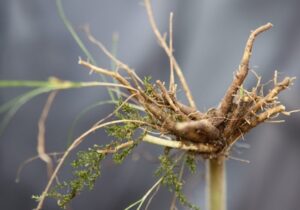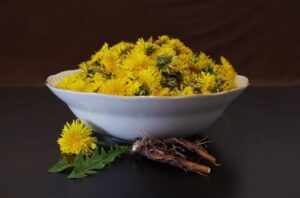To Autumn
John Keats – 1795-1821
Season of mists and mellow fruitfulness,
Close bosom-friend of the maturing sun;
Conspiring with him how to load and bless
With fruit the vines that round the thatch-eves run;
To bend with apples the moss’d cottage-trees,
And fill all fruit with ripeness to the core;
To swell the gourd, and plump the hazel shells
With a sweet kernel; to set budding more,
And still more, later flowers for the bees,
Until they think warm days will never cease,
For summer has o’er-brimm’d their clammy cells.
Who hath not seen thee oft amid thy store?
Sometimes whoever seeks abroad may find
Thee sitting careless on a granary floor,
Thy hair soft-lifted by the winnowing wind;
Or on a half-reap’d furrow sound asleep,
Drowsed with the fume of poppies, while thy hook
Spares the next swath and all its twined flowers:
And sometimes like a gleaner thou dost keep
Steady thy laden head across a brook;
Or by a cider-press, with patient look,
Thou watchest the last oozings, hours by hours.
Where are the songs of Spring? Ay, where are they?
Think not of them, thou hast thy music too,–
While barred clouds bloom the soft-dying day,
And touch the stubble-plains with rosy hue;
Then in a wailful choir the small gnats mourn
Among the river shallows, borne aloft
Or sinking as the light wind lives or dies;
And full-grown lambs loud bleat from hilly bourn;
Hedge-crickets sing; and now with treble soft
The redbreast whistles from a garden-croft,
And gathering swallows twitter in the skies.
Written September 19, 1819
How to harvest roots in the fall
My good friends all know that I love poetry and I am just as likely to buy poetry books as herb books these days. There is something so comforting about escaping into beautifully crafted stanzas that are evocative and moving.
This poem by Keats is 200 years old and yet still timeless. Although he does not speak about digging roots, we can be sure that country folk of the era were harvesting their root crops alongside the hazelnuts and squash. Here at Innisfree, we have had a great harvest of roots in the last month and have been busy scrubbing, chopping and drying, seemingly for hours. This is a good time, while keeping our hands busy, to share stories and enjoy the last late sunny days of the season.
The best time to harvest roots is in the mid fall, when the leaves are still on the plant to show you what it is, but the colours are fading and they are no longer carrying out photosynthesis to send energy to the roots. This is the time when the roots will have the highest amount of sugars, minerals and other key constituents, but the ground is still not too muddy or too frozen for digging. You can harvest roots in the spring, but you have to do it fast before the leaves start growing and sucking the energy back up from underground.
The technique is very simple. All you need is a good digging fork and a strong back. Loosen the dirt with the digging fork on all four sides of the plant, then work the fork underneath as best you can to loosen the roots so that you can pull them up. Shake off as much dirt as possible then scrub very well. Some plants are quite easy to clean, if a bit time consuming, like the chicory and the dandelion shown here, which are a fairly good size and can be scrubbed.
Others may be more fibrous and matted such as echinacea root, and this can be really challenging to clean. You may need to soak the roots for 30 minutes in cold water to soften and loosen the dirt. A strong spray from a garden hose can be helpful and I have even seen people using a pressure washer in a large bucket or barrel for bigger volumes of roots. If you are harvesting on a commercial scale, you may consider trying a repurposed cement mixer with water and gravel, and one herbalist I know saves all their nutshells through the winter and uses them as an abrasive agent in the cement mixer to knock off the dirt.
Once you have cleaned your roots well, you need to go ahead and chop them up into very small pieces right away as they will become very hard as they dry. I use the slicing blade of my food processor whenever I can, as it saves time and effort, but otherwise a very sharp cleaver or knife or a pair of hand clippers (secateurs) may be effective.
Place sheets of window screening on your drying racks to stop small pieces falling through, or dry them on large cookie sheets with a cotton cloth to stop the root from having direct contact to the metal.
Roots can usually take a little more heat than the leaves and flowers, around 35 to 38 degrees is fine. You do want plenty of airflow to reduce the likelihood of molding and turn them every day also to dry them evenly. Roots are properly dried when they are brittle and snap cleanly, and are no longer flexible or soft.
Store them in an airtight container in a cool place and in the dark, and they will keep well for one to two years.
Roots we have been harvesting recently
Valerian
Marshmallow
Echinacea
Chicory
Dandelion
And a few other herbs we are also harvesting now
Black elderberry and rosehips to cook down with honey to make a syrup for viral infections
Cornsilk to dry and make a tea for bladder inflammation and irritation
Red Clover and hibiscus are late flowering this year so we are still harvesting them teas
Goldenrod leaves and flower buds, also late this year, for sinus congestion, allergies and to
flush the kidneys and bladder
Stinging nettle seed for kidney repair
Alder bark as a strong astringent
Cascara bark as a laxative – don’t forget it needs to be stored for one to two years before use


